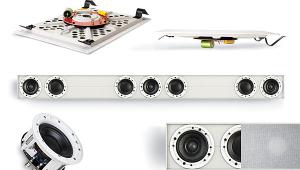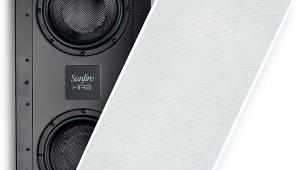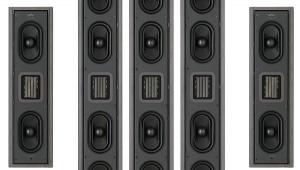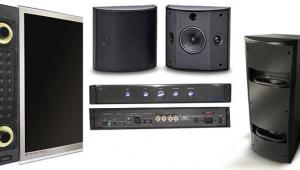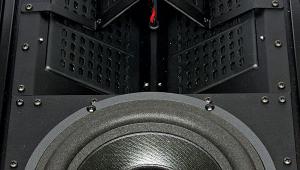Episode ES-HT700 In-Ceiling Speaker System
Hitting the Class Ceiling

We hold these truths to be self-evident: that all men are created equal, that they are endowed by their Creator with the ability to watch any movie they want (even Avatar in 2D), and that they should never, ever use in-ceiling speakers for a home theater. After all, you want Sigourney Weaver’s gravelly, “Where’s my god damn cigarette?” to sound like it’s coming from the screen, not the light fixtures above your head, right?
But the ceiling is where it’s at—for some folks, anyway. These poor mortals are cursed with a home theater room that doesn’t allow for freestanding speakers or even, sadly, a diminutive powered subwoofer. The compromising factor might be aesthetics (curses, you designer-types) or ergonomics (curses, you furniture, walkways, and fireplaces). Whatever the reason, the end result is that there won’t be any speakers on the floor, darling. At this point, if you’re in the business of selling home theater gear or you’re an intrepid homeowner desperately trying to find a way to get a theater to fit into your home, the next logical place for speakers is in the wall. Fortunately, in-wall speaker designs have improved over the years, and you can find a number of really good-sounding speakers to install in the wall.
Ah, the sweet sound of a drywall knife slicing through gypsum. Alas, there are some homes where even in-wall speakers won’t go. Things like studs, windows, paintings, and (once again) fireplaces have a bad habit of locating themselves exactly where speakers ought to be. With speakers on the floor not being an option, and since no one in the industry has developed a levitating, invisible speaker, the only location left is the ceiling. (Yes, tens of thousands of readers just cringed at the thought of that.)
Angles of Approach
Various companies have attempted to address these issues with differing approaches. SpeakerCraft and KEF, for instance, offer motorized in-ceiling speakers that, when not in use, rest flush with the ceiling but very slowly (and sexily, I might add) descend to a position that angles the speaker downward toward the main listening area. The sound quality of some of these speakers is surprisingly good, but unfortunately, the price is usually high because the mechanisms required to move the speakers aren’t cheap. An alternative option utilizes a fixed surface-mount cabinet that angles the drivers toward the listening area. This eliminates the cost of the motors, but it also limits the aesthetic appeal. The most common solution is to slam a round speaker into the ceiling and abandon all hope of listening to anything other than background music. Many of these traditional in-ceiling speakers now utilize pivoting tweeters (and some offer pivoting midbass drivers, too) that give the sound at least a slight chance of reaching your ears unimpeded. But while this might improve the speakers’ perceived high-frequency performance, the imaging and overall fidelity can in some instances be less than optimal.
There are a few companies—Definitive Technology, Triad, and the relatively unknown Episode—that turn the surface-mount ceiling speaker concept 180 degrees—vertically. (If they did it horizontally, the speakers would just point backwards. Not a good marketing move there.) In other words, instead of screwing the speaker cabinet onto the ceiling, these guys recess the entire cabinet into the attic space above the ceiling. (Of course, this only works if you have attic space. Having the back of the speaker sticking out of the floor on the second story would be another poor marketing move.) When I spoke with Adam Levy, vice president of marketing for Episode, he agreed that in-ceiling speakers wouldn’t normally be the first choice for a kick-ass system (my term, not his); but he quickly pointed out two advantages to an in-ceiling design over an in-wall version. The first is aesthetics. People don’t notice grilles on the ceiling anywhere near as much as they notice them on the walls. The second is a potential performance advantage. For ceilings with an attic or at least some crawl space above, depth of installation is no longer an issue—unlike the approximately 4-inch limit for a typical in-wall speaker. So an in-ceiling cabinet can be made with a baffle that recesses into the speaker’s enclosure up in the ceiling. The enclosure itself can then be made as deep as it needs to be (within reason, of course) to get good performance.
Epi-Who?
Before I go any further, who exactly is Episode? It’s part of a six-year-old company that specializes in all things custom install. To my knowledge, it doesn’t advertise very much, if at all, to the average Joe, and its products are only available through custom installation dealers. Two years ago, its president and founder Jay Faison decided to completely redesign the three-year-old Episode line. With a decade of custom installation experience under his belt, he had some definite opinions on what did and didn’t work in typical installations. He set out to pair high-performance speaker technology with realworld experience, to create a speaker line that sounds good in a home, not just a testing lab. Attention to and experience in the custom install industry can mean a lot. It can also be an excuse for resting on those oh-so-soft laurels, too. None of us at Home Theater had heard any Episode speakers prior to this review, but the company gave a good pitch, so we decided to give them a shot and see if they could send us a complete seven-channel in-ceiling system that was even remotely good enough to consider for a review.
- Log in or register to post comments



